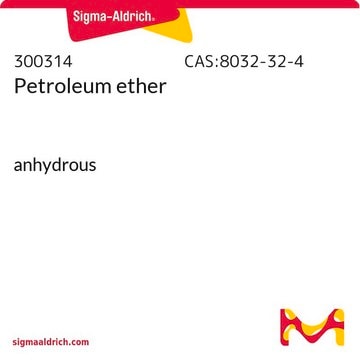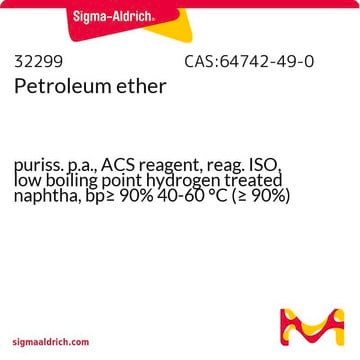1.00915
Etere di petrolio
boiling range to about 40°C EMPLURA®
Sinonimo/i:
Petroleum ether, Petroleum spirit, Petroleum ether
About This Item
Prodotti consigliati
Livello qualitativo
Nome Commerciale
EMPLURA®
Forma fisica
liquid
Temp. autoaccensione
245 °C
Limite di esplosione
1.3-7.8 % (v/v)
Impurezze
≤0.00002% Al (Aluminium)
≤0.0005% Free acid (as CH3COOH)
≤0.01% Aromatics (as benzene)
≤0.01% Sulfur compounds (as S)
≤0.01% Water
Residuo dopo evaporazione
≤0.0020%
P. eboll.
<40 °C/1013 hPa
Numero di bromo
≤3
Temp. transizione
flash point -56 °C
Densità
0.63 g/cm3 at 20 °C
Cationi in tracce
Al: ≤0.00002%
Ba: ≤0.00001%
Ca: ≤0.0001%
Cd: ≤0.00001%
Co: ≤0.00001%
Cr: ≤0.000003%
Cu: ≤0.000003%
Fe: ≤0.000003%
K: ≤0.00003%
Mg: ≤0.00001%
Mn: ≤0.000003%
Na: ≤0.0001%
Ni: ≤0.000003%
Pb: ≤0.00001%
Sr: ≤0.000003%
Zn: ≤0.00003%
Temperatura di conservazione
2-30°C
Cerchi prodotti simili? Visita Guida al confronto tra prodotti
Categorie correlate
Descrizione generale
Applicazioni
- Ginkgo Biloba L. Exocarp Extracts: Utilizing petroleum benzine for solvent extraction, this research explores the anti-microbial potential of Ginkgo biloba L. exocarp extracts against methicillin-resistant Staphylococcus aureus, indicating its significant role in pharmaceutical applications (Wei et al., 2024).
- Creating Mesopores in ZSM-5 Catalyst for Aromatics Production: This application of petroleum benzine in the synthesis of biodiesel-derived waste glycerol showcases innovative use in catalytic processes to enhance aromatic production, beneficial for both environmental and industrial chemistry (Kumar et al., 2024).
- High-Speed Countercurrent Chromatography for Bioactive Neolignan Isomers: Demonstrating the use of petroleum benzine in chromatographic techniques, this method significantly aids in the isolation of complex organic compounds, crucial for advanced research in natural product chemistry (Xiao et al., 2024).
- Hydrocarbon Ingestions and Poison Control: While indirectly related, the study uses data on hydrocarbon ingestions to emphasize the importance of safety and environmental impact assessments in the use of petroleum products, including benzine, within public health contexts (Palmer et al., 2023).
Risultati analitici
Free acid (as CH₃COOH): ≤ 0.0005 %
Density (d 20 °C/ 4 °C): 0.623 - 0.627
Readily carbonizable substances: conforms
Evaporation residue: ≤ 0.0020 %
Water: ≤ 0.010 %
Aromatics (as benzene): ≤ 0.01 %
Sulfur compounds (as S): ≤ 0.01 %
Bromine number: ≤ 3
Al (Aluminium): ≤ 0.00002 %
Ba (Barium): ≤ 0.00001 %
Ca (Calcium): ≤ 0.0001 %
Cd (Cadmium): ≤ 0.00001 %
Co (Cobalt): ≤ 0.00001 %
Cr (Chromium): ≤ 0.000003 %
Cu (Copper): ≤ 0.000003 %
Fe (Iron): ≤ 0.000003 %
K (Potassium): ≤ 0.00003 %
Mg (Magnesium): ≤ 0.00001 %
Mn (Manganese): ≤ 0.000003 %
Na (Sodium): ≤ 0.0001 %
Ni (Nickel): ≤ 0.000003 %
Pb (Lead): ≤ 0.00001 %
Sr (Strontium): ≤ 0.000003 %
Zn (Zinc): ≤ 0.00003 %
Note legali
Avvertenze
Danger
Indicazioni di pericolo
Consigli di prudenza
Classi di pericolo
Aquatic Chronic 2 - Asp. Tox. 1 - Flam. Liq. 1 - Skin Irrit. 2 - STOT SE 3
Organi bersaglio
Respiratory system
Codice della classe di stoccaggio
3 - Flammable liquids
Classe di pericolosità dell'acqua (WGK)
WGK 3
Punto d’infiammabilità (°F)
-68.8 °F
Punto d’infiammabilità (°C)
-56 °C
Certificati d'analisi (COA)
Cerca il Certificati d'analisi (COA) digitando il numero di lotto/batch corrispondente. I numeri di lotto o di batch sono stampati sull'etichetta dei prodotti dopo la parola ‘Lotto’ o ‘Batch’.
Possiedi già questo prodotto?
I documenti relativi ai prodotti acquistati recentemente sono disponibili nell’Archivio dei documenti.
I clienti hanno visto anche
Il team dei nostri ricercatori vanta grande esperienza in tutte le aree della ricerca quali Life Science, scienza dei materiali, sintesi chimica, cromatografia, discipline analitiche, ecc..
Contatta l'Assistenza Tecnica.










